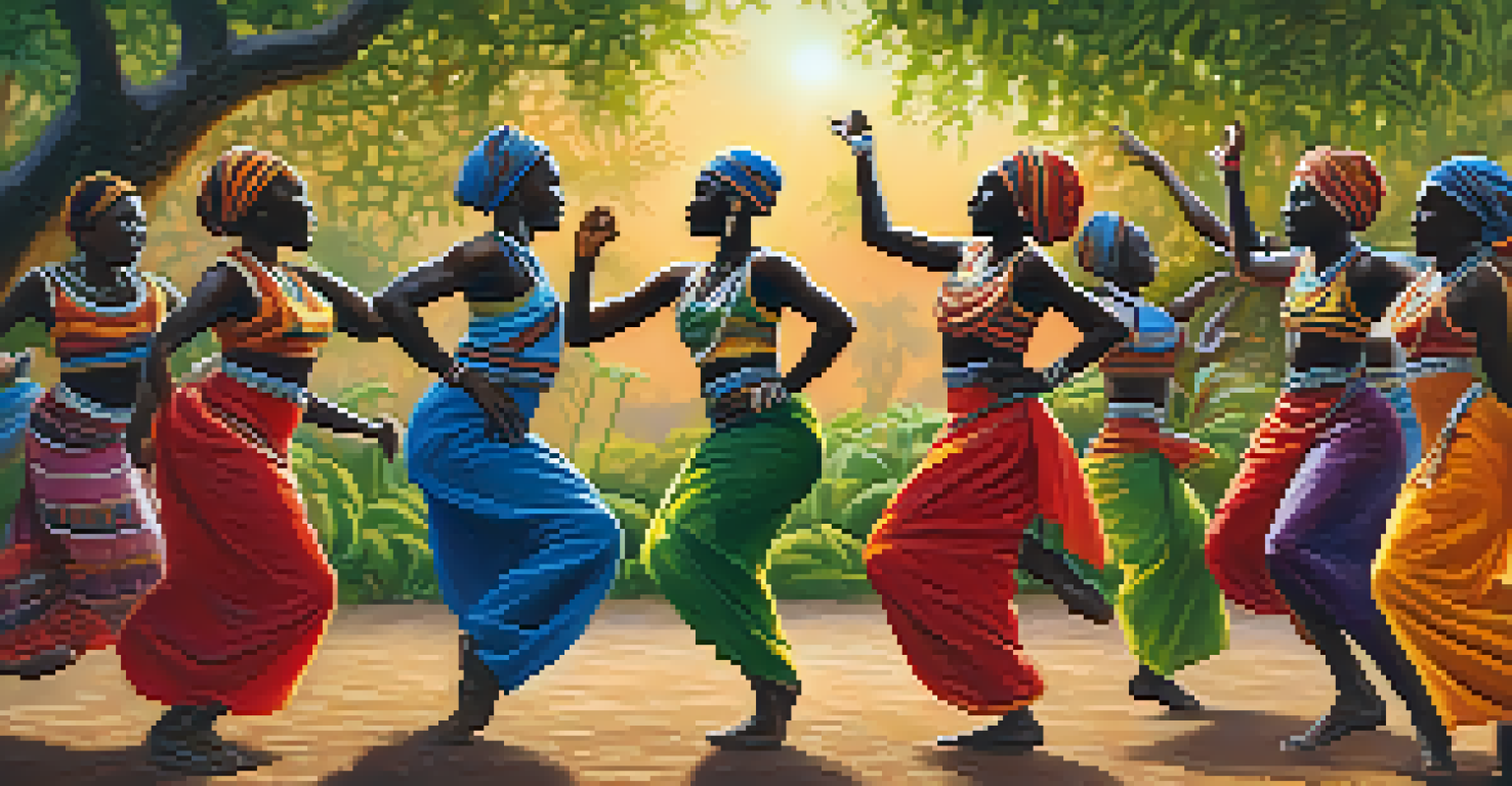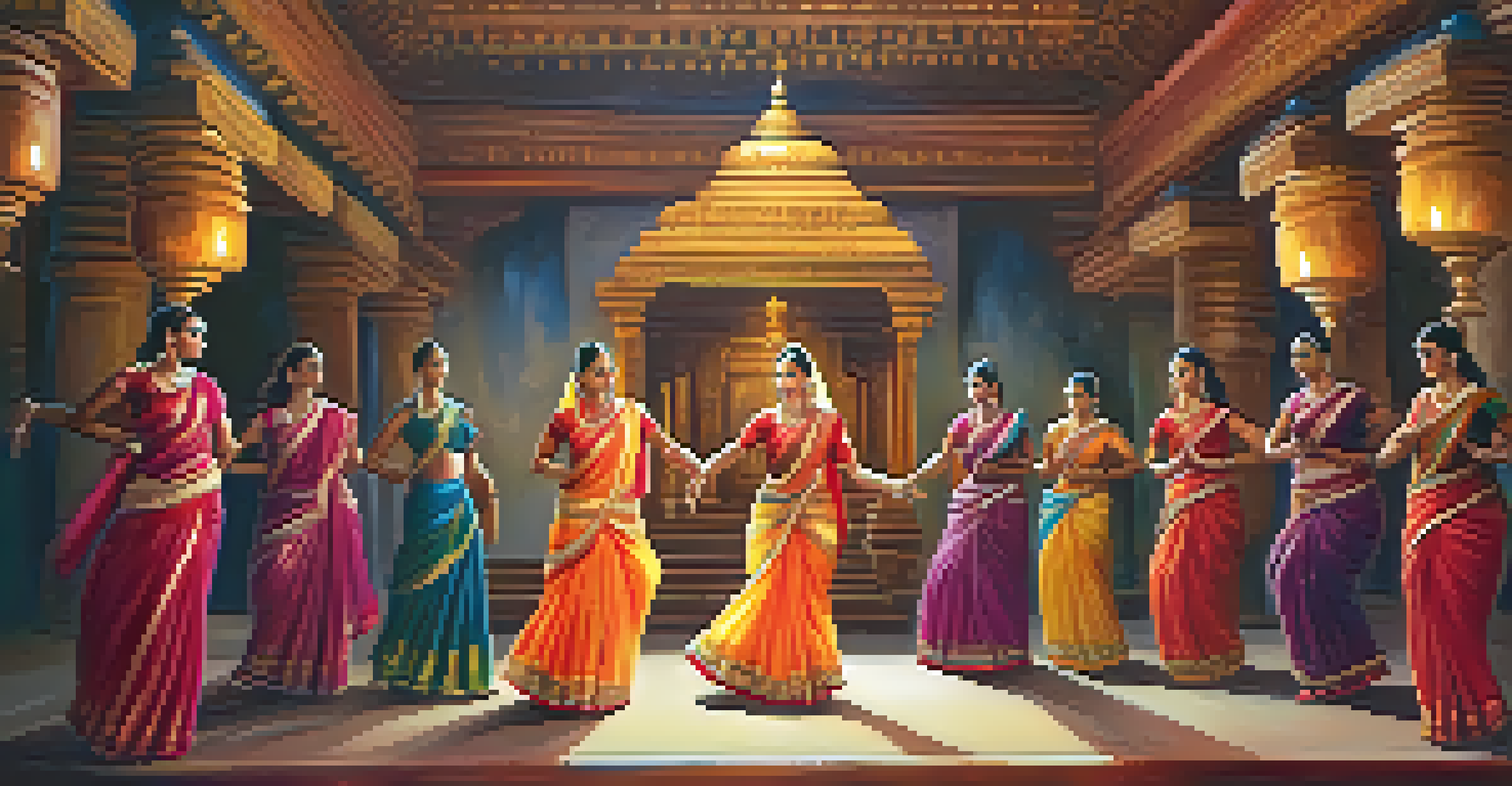Dance, Memory, and Emotion: A Complex Interrelation

Understanding Dance as a Form of Expression
Dance is more than just movement; it's a powerful form of expression that transcends words. Through rhythm and motion, individuals convey feelings that might be hard to articulate. Whether it's a joyous celebration or a heartfelt sorrow, dance allows us to express our deepest emotions in a unique way. This expressive nature of dance connects us to our own experiences and the experiences of others.
Dance is the hidden language of the soul.
For instance, think back to a wedding dance; the way the couple moves together often encapsulates their love and commitment. This visual representation of emotion can evoke similar feelings in those who witness it, creating a shared experience. Dance acts as a bridge, connecting our inner feelings with the external world, making it a universal language.
Moreover, the cultural significance of dance varies widely, influencing how it's perceived and experienced. In some cultures, dance is a vital part of storytelling, while in others, it's a ritualistic practice. This multifaceted nature of dance highlights its role in shaping our emotional landscape and memory.
The Role of Memory in Dance
Memory plays a crucial role in how we experience dance, both as performers and spectators. Dancers often rely on muscle memory to execute complex movements, recalling their training and past performances. This allows them to express emotions authentically, as their bodies remember the feelings tied to those movements.

For audiences, dance can trigger personal memories, making performances feel deeply resonant. A particular song or movement may remind someone of a cherished moment from their past, evoking nostalgia and emotional responses. This intertwining of memory and dance creates a rich tapestry of experience for both dancer and viewer.
Dance as Universal Expression
Dance transcends language, allowing individuals to convey deep emotions and connect with others through movement.
Additionally, the act of learning and performing dance can enhance cognitive function, strengthening memory retention. Engaging with dance not only allows us to express ourselves but also helps us remember and connect with our past, reinforcing the bond between movement and memory.
Emotions Influenced by Dance
Dance has the remarkable ability to evoke a wide range of emotions, from joy and exhilaration to sadness and reflection. The way dancers convey these emotions through their movements can resonate deeply with audiences, often leading to a shared emotional experience. For example, a poignant ballet performance can leave viewers feeling a profound sense of empathy for the characters depicted.
Dance is the joy of movement and the heart of life.
Moreover, the music that accompanies dance plays a significant role in shaping emotional responses. The tempo, melody, and rhythm can enhance the feelings conveyed through movement, creating a more immersive experience. A fast-paced song might inspire excitement and energy, while a slow, melancholic tune can evoke feelings of introspection and sorrow.
This emotional connection can also be therapeutic. Many individuals find solace in dance as a way to process their feelings, using movement to work through grief, anger, or anxiety. In this way, dance becomes a powerful tool for emotional healing, illustrating its profound impact on our emotional well-being.
Cultural Influences on Dance and Emotion
Cultural background significantly shapes how dance is perceived and experienced, influencing the emotions that are expressed. Different cultures have unique dance forms that embody specific emotions and stories, often tied to their history and traditions. For instance, traditional African dance often celebrates community and joy, while classical Indian dance can express a range of emotions through intricate gestures and facial expressions.
These cultural nuances enrich the emotional landscape of dance. When we engage with various dance forms, we not only witness the movement but also experience the emotions deeply rooted in that culture. This can broaden our understanding and appreciation of different emotional expressions, fostering empathy and connection.
Memory's Role in Dance Experience
Both performers and audiences utilize memory in dance, enriching their emotional connections and enhancing performances.
Additionally, as cultures blend and evolve, so too do the emotions expressed through dance. Contemporary dance often fuses styles from various traditions, creating new pathways for emotional expression. This blending not only reflects our increasingly interconnected world but also highlights the evolving nature of dance as a medium for sharing diverse emotional experiences.
Dance as a Memory Trigger
Certain songs or movements can act as powerful memory triggers, bringing back vivid recollections of past experiences. Many people can relate to a specific song reminding them of a dance at a significant life event, such as a graduation or a wedding. In this sense, dance becomes a vessel for memory, transporting us back to moments that shaped our lives.
Research shows that the combination of music and movement can enhance memory recall, tapping into the emotional connections we have with certain experiences. This phenomenon highlights the importance of dance not just as an art form, but as a tool for memory preservation. The emotions tied to these memories can significantly influence how we feel in the present.
Moreover, dance therapy often utilizes this concept, helping individuals reconnect with memories and emotions through movement. By engaging with dance, people can explore their past, process their experiences, and even heal from emotional trauma. This illustrates the profound relationship between dance, memory, and our emotional landscape.
The Science Behind Dance and Emotion
Recent studies in neuroscience have started to unravel the connections between dance, memory, and emotion. Researchers have found that dancing activates various areas of the brain, including those responsible for emotion and memory processing. This activation can enhance our emotional experiences, making dance a potent medium for expressing and evoking feelings.
Additionally, the physical activity involved in dance releases endorphins, which are known as 'feel-good' hormones. This biochemical response can elevate mood and create a sense of well-being, further intertwining dance with emotional health. When we dance, we're not just moving our bodies; we're engaging in a complex neurological process that fosters emotional expression.
Cultural Influences Shape Emotions
Cultural backgrounds influence the emotions expressed in dance, creating unique narratives that foster empathy and understanding.
Understanding the science behind this relationship can help us appreciate the value of dance in our lives. Whether it's dancing for joy, processing grief, or simply enjoying the rhythm, the interplay of dance, memory, and emotion is a fascinating area of study that underscores the importance of movement in human experience.
Conclusion: The Interconnection of Dance, Memory, and Emotion
In conclusion, the relationship between dance, memory, and emotion is intricate and profound. Dance serves as a unique form of expression that allows us to connect with our own emotions and those of others. Through movement, we can evoke memories, trigger feelings, and even heal from emotional wounds, making dance a powerful tool in our emotional repertoire.
As we continue to explore various dance forms and their cultural significance, we deepen our understanding of how these interactions shape our emotional experiences. Each dance tells a story, weaving together personal and collective histories that resonate on multiple levels. This rich tapestry highlights the importance of dance in human connection and emotional expression.

Ultimately, engaging with dance opens up a world of emotional exploration, allowing us to celebrate our joys and navigate our sorrows. As we move through life, let’s embrace the power of dance to enrich our memories and illuminate our emotional journeys.